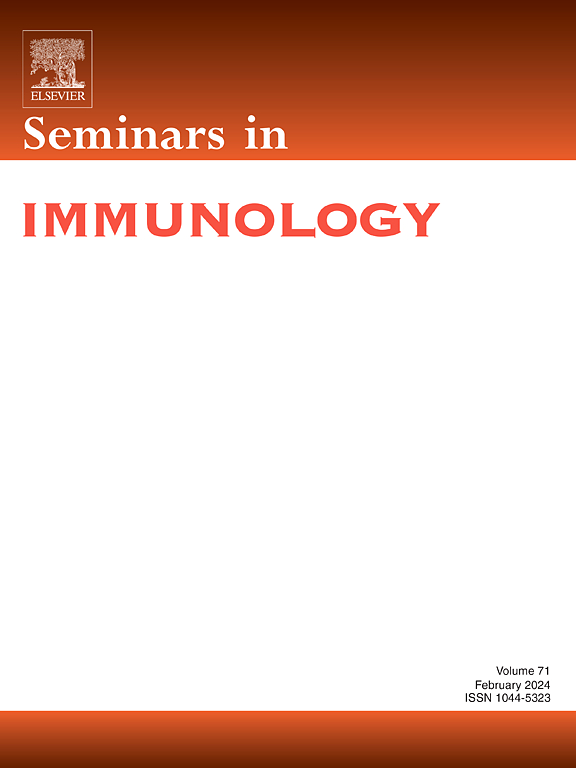ABO blood groups and galectins: Implications in transfusion medicine and innate immunity
IF 7.4
2区 医学
Q1 IMMUNOLOGY
引用次数: 0
Abstract
ABO blood group antigens, which are complex carbohydrate moieties, and the first human polymorphisms identified, are critical in transfusion medicine and transplantation. Despite their discovery over a century ago, significant questions remain about the development of anti-ABO antibodies and the structural features of ABO antigens that cause hemolytic transfusion reactions. Anti-ABO antibodies develop naturally during the first few months of life, in contrast to other red blood cell (RBC) alloantibodies which form after allogeneic RBC exposure. Anti-ABO antibodies are the most common immune barrier to transfusion and transplantation, but the factors driving their formation are incompletely understood. Some studies suggest that microbes that express glycans similar in structure to the blood group antigens could play a role in anti-blood group antibody formation. While the role of these microbes in clinically relevant anti-blood group antibody formation remains to be defined, the presence of these microbes raises questions about how blood group-positive individuals protect themselves against blood group molecular mimicry. Recent studies suggest that galectins can bind and kill microbes that mimic blood group antigens, suggesting a unique host defense mechanism against microbial molecular mimicry. However, new models are needed to fully define the impact of microbes, galectins, or other factors on the development of clinically relevant naturally occurring anti-blood group antibodies.
ABO 血型和半凝血酶:输血医学和先天免疫的意义
ABO 血型抗原是一种复杂的碳水化合物分子,也是最早发现的人类多态性,在输血医学和移植中至关重要。尽管抗 ABO 抗体在一个多世纪前就已被发现,但关于抗 ABO 抗体的产生以及导致溶血性输血反应的 ABO 抗原结构特征的重大问题依然存在。抗ABO抗体是在婴儿出生后的头几个月自然产生的,而其他红细胞(RBC)异体抗体则是在接触异体RBC后形成的。抗逆转录病毒抗体是输血和移植最常见的免疫屏障,但其形成的驱动因素尚不完全清楚。一些研究表明,表达与血型抗原结构相似的聚糖的微生物可能在抗血型抗体的形成中发挥作用。虽然这些微生物在临床相关的抗血型抗体形成中的作用仍有待确定,但这些微生物的存在提出了血型阳性者如何保护自己免受血型分子模仿的问题。最近的研究表明,半凝集素能结合并杀死模仿血型抗原的微生物,这表明宿主有一种独特的防御机制来抵御微生物的分子模仿。然而,要全面确定微生物、半凝集素或其他因素对临床相关的自然产生的抗血型抗体的影响,还需要新的模型。
本文章由计算机程序翻译,如有差异,请以英文原文为准。
求助全文
约1分钟内获得全文
求助全文
来源期刊

Seminars in Immunology
医学-免疫学
CiteScore
11.40
自引率
1.30%
发文量
50
审稿时长
89 days
期刊介绍:
Seminars in Immunology is a specialized review journal that serves as a valuable resource for scientists in the field of immunology. The journal's approach is thematic, with each issue dedicated to a specific topic of significant interest to immunologists. It covers a wide range of research areas, from the molecular and cellular foundations of the immune response to the potential for its manipulation, highlighting recent advancements in these areas.
Each thematic issue is curated by a guest editor, who is recognized as an expert in the field internationally. The content of each issue typically includes six to eight authoritative invited reviews, which delve into various aspects of the chosen topic. The goal of these reviews is to provide a comprehensive, coherent, and engaging overview of the subject matter, ensuring that the information is presented in a timely manner to maintain its relevance.
The journal's commitment to quality and timeliness is further supported by its inclusion in the Scopus database, which is a leading abstract and citation database of peer-reviewed literature. Being indexed in Scopus helps to ensure that the journal's content is accessible to a broad audience of researchers and professionals in immunology and related fields.
 求助内容:
求助内容: 应助结果提醒方式:
应助结果提醒方式:


